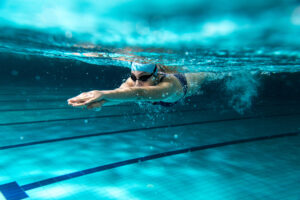
It’s time to take the plunge and talk about the form of exercise that sends shivers down my spine. Yep, swimming.
It is one of those activities that we all know is really good for you but, for many of us, it is the one cardio activity that really challenges our motivation levels.
Why swimming?
Swimming is so good for our bodies and minds. Among its many benefits, it is easy on the joints; develops our cardio vascular system without putting too much stress on the rest of the body; builds muscle strength; tones muscles; contributes towards the repair of injuries; and helps us maintain a healthy weight.
Really, what’s not to like. And if that wasn’t enough, many swimmers talk about the mental relaxation afforded by swimming. It is a relaxing and peaceful form of exercise, which can’t be interrupted by the beep of a message or the ting of an email.
Read more about the benefits of swimming here:
So how can non-swimmers get over their fear of stepping into the water?
Take some lessons
The first thing would be to learn the correct technique. We will probably all have learnt to swim with a minimum level of efficiency as school children. Getting a personal trainer for a few sessions will brush up those old skills and introduce some new techniques. Re-learning how to swim is one of the most common factors cited by people who have successfully returned to the pool or the sea after a long time away.
Learn how to breathe
This is something that many people struggle with but, even if you don’t go to a swimming teacher, there are some exercises you can practice to build your confidence.
• Standing in the water with your head on the surface and turn your head to the side and breathe in. Then put your head in the water and breathe out. Repeat that a few times to get a feel of the breathing pattern.
• Begin to use this in your stroke, slightly moving your head to breathe and getting used to breathing in and out of your mouth.
• If you have access to a pool with shallower water, you can use your legs to walk on the bottom of the pool and then use your arms like you are swimming and get a feel of the breathing pattern while walking in the pool. This would let you focus solely on breathing and then you can gradually bring the legs into it.
Use equipment to improve technique
There is some great equipment out there to help you improve. You can target parts of the body to work on or stroke improvement. Finger paddles keep your stroke nice and long and give you feedback on your stroke. Fins are a great way to strengthen your legs and to work on certain stroke patterns. They also give you greater propulsion through the leg part of your stroke too. A simple float held outstretched in your hands will help you align your body in the water correctly.
Mix it up
Try and use a variety of muscles in your sessions, working on different strokes and different parts of the stroke. Kicking is a great way to focus on your lower body and a pull buoy is a great way to isolate your upper body. If you mix it up, you will benefit from a full body workout.
Dress for success
It sounds simple but having the right swimming togs and a good pair of goggles makes all the difference. If you are confident in how you look as you slide into the water, then you will have more confidence as you start to swim. If you are considering swimming in lakes or the sea, then look for a wet suit that will keep you warm.
There is no denying it: swimming is a great all-round exercise activity and one that we should all do a bit more of.







